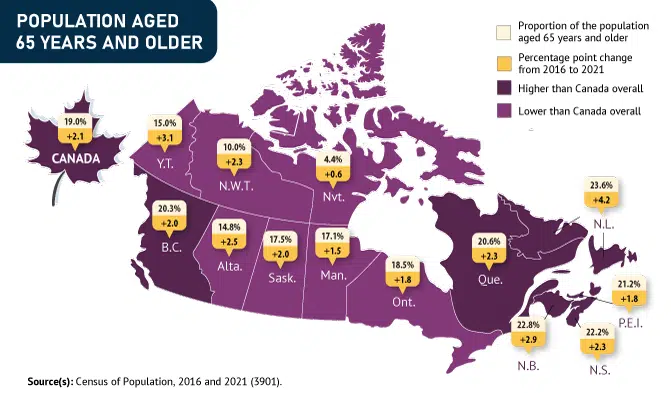Canada is facing record retirements from an aging labour force amid high job vacancies and historically low unemployment.
Statistics Canada released its latest round of data Wednesday from the most recent census conducted in 2021.
Laurent Martel, director of the organization’s Centre for Demography, said the number of working-age people facing retirement has never been so high.
“One in five Canadians among the working-age population is currently between the age of 55 and 64, likely to exit the labour force if not already done,” Martel told reporters on Wednesday.
According to the data, 21.8 per cent of working-age people across Canada — those aged 15 to 64 — fall into that category.
The aging of many baby boom cohorts — the youngest of whom are between 56 and 64 years today — is accelerating population aging in general, said the report.
“There are very large implications of this situation, and it is certainly one factor explaining the current labour shortages that Canada is experiencing,” said Martel.
From 2016 to 2021, the number of people aged 65 and older rose 18.3 per cent to 7 million. That represents nearly one-in-five Canadians (19 per cent), up from 16.9 per cent in 2016.
The country’s senior population has also grown six times faster than children under the age of 15, which is now at a total of 6 million.
The new data also shows the number of people 85 and older has doubled over the past 20 years, reaching 861,000 in 2021. Population projections suggest that number could triple within the next 25 years.
Statistics Canada said the demographic shifts are due to low fertility, the gradual increase in life expectancy, and the fact that the large baby boom generation started turning 65 in 2011.
“Immigration has a rejuvenating effect on the Canadian population, but this effect is not enough to stop the population aging process,” said Wednesday’s report.
N.B. no longer the oldest province
Newfoundland and Labrador has overtaken New Brunswick for the oldest population in Canada.
The province’s average age is 45.5, with 23.6 per cent of residents falling into the 65+ age category.
New Brunswick is a close second with an average age of 44.7 years old. A total of 22.8 per cent of the population is aged 65 and older.
With an average age of 44.2 years old, Nova Scotia is the third oldest province in the country; 22.2 per cent of its population is aged 65 and older.
Rounding out the top five in Prince Edward Island (43.1 years old) and Quebec (42.8 years old).
Canada’s average age is 41.9, up nearly one year from the 2016 census.
Of Canada’s 10 provinces, Alberta has the youngest population with an average age of 39 years old. Just under 15 per cent of its population is in the 65+ age category.
But when you add in the territories, Nunavut is the youngest. Only 4.4 per cent of its population is aged 65 and older and it has an average age of 28.3.
Below is the average age for each province and territory, from oldest to youngest:
- Newfoundland and Labrador: 45.5
- New Brunswick: 44.7
- Nova Scotia: 44.2
- Prince Edward Island: 43.1
- British Columbia: 43.1
- Quebec: 42.8
- Ontario: 41.8
- Saskatchewan: 39.8
- Yukon: 39.9
- Manitoba: 39.7
- Alberta: 39
- Northwest Territories: 36.4
- Nunavut: 28.3
Gender diversity data
For the first time, the most recent census also included data relating to gender diversity.
Nearly 101,000 people 15 and older (1 in 300 people) reported themselves as transgender or non-binary, accounting for 0.33 per cent of the population in this age group.
The proportions of transgender and non-binary people were three to seven times higher for Generation Z (born between 1997 and 2006) and millennials (born 1981 to 1996) than for Generation X (born 1966 to 1980), baby boomers (born 1946 to 1965) and the Interwar and Greatest Generations (born in 1945 or earlier).
Nova Scotia, Yukon and British Columbia had the highest proportions of transgender and non-binary people aged 15 and older among provinces and territories.
Victoria, B.C., Halifax, N.S., and Fredericton, N.B., had the most gender diversity among Canadian large urban centres.
New data from the #2021Census are now available:
• Age and type of dwelling: https://t.co/8LCaDd0lM9
• Sex at birth and gender: https://t.co/RVLsQFLzAQCheck out the thread below for some key highlights:
pic.twitter.com/PWHW7Gmbh2
— Statistics Canada (@StatCan_eng) April 27, 2022









